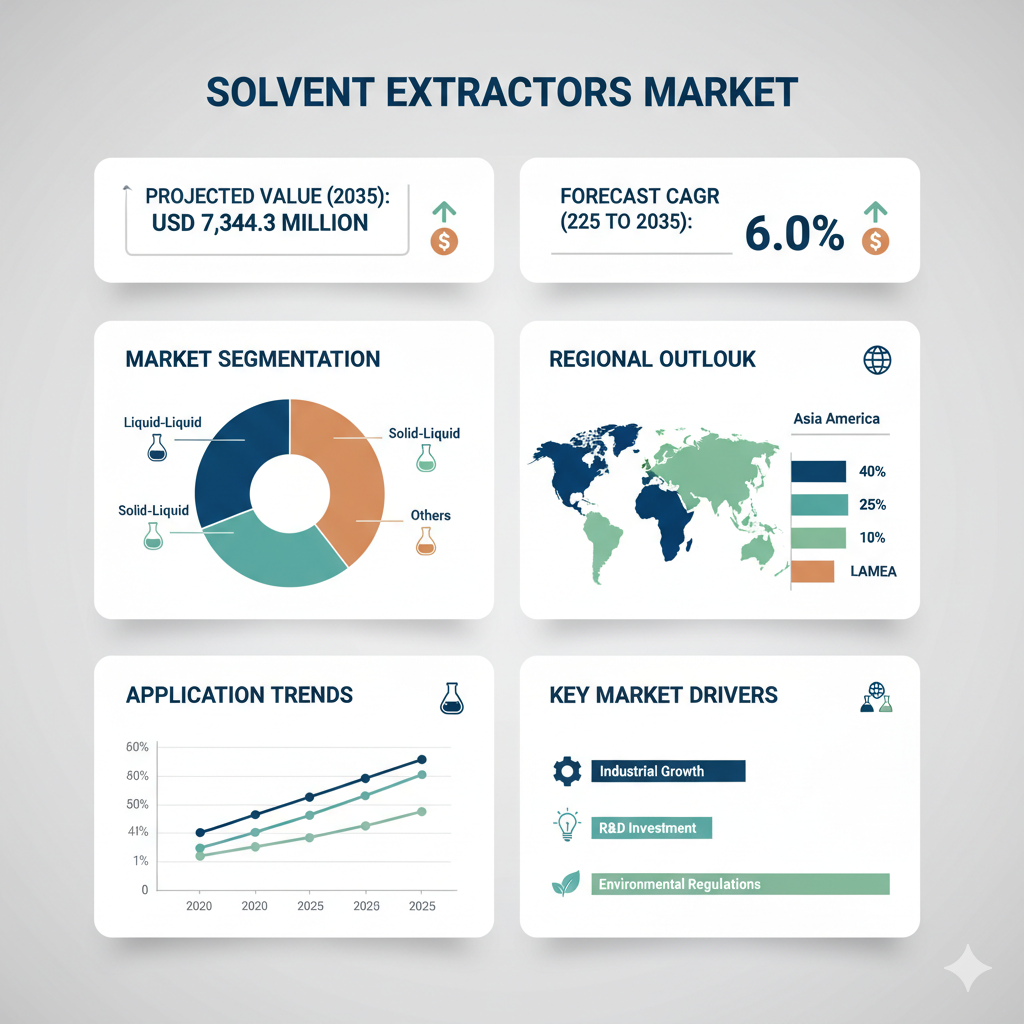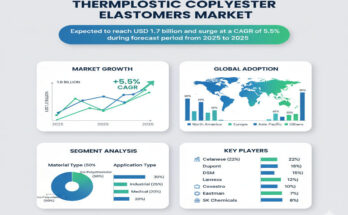The global solvent extractors market is set to undergo steady expansion over the next decade. In 2025, the market value is estimated at USD 4,101 million and is expected to rise to USD 7,344.3 million by 2035. This reflects a compound annual growth rate (CAGR) of 6.0% during the forecast period from 2025 to 2035.
This growth is being driven by several key factors. Rising global consumption of edible oils, fueled by population growth and changing dietary patterns, is a major contributor. At the same time, increasing demand in the pharmaceutical and nutraceutical industries for high-purity bioactive compounds is opening new opportunities. The growing shift toward renewable, bio-based products, including biofuels and specialty chemicals, further supports long-term demand for solvent extractors.
Market Segmentation by Product Type
By product type, the market is divided into batch solvent extraction equipment, continuous solvent extraction equipment, and others. Batch solvent extraction equipment currently accounts for the largest share, representing around 36 percent of the market in 2025. Its flexibility and precision make it particularly valuable for small to medium-scale production and applications requiring high levels of purity, such as pharmaceuticals and specialty extracts. Continuous solvent extraction equipment is also showing strong potential as industries look for higher throughput solutions that can handle large-volume operations efficiently.
Market Segmentation by Application
Applications of solvent extractors extend across pharmaceuticals, food and beverages, chemicals, oil and gas, and several other sectors. Among these, the pharmaceutical and nutraceutical segment stands out due to rising consumer interest in herbal remedies, dietary supplements, and preventive healthcare. High-quality extractions are essential in these industries, giving solvent extraction equipment a critical role. The food and beverage sector, particularly in edible oil production, continues to dominate overall demand and remains a cornerstone of the industry.
Market Segmentation by Operation
From an operational perspective, solvent extractors can be manual, semi-automatic, or fully automatic. The semi-automatic category is gaining increasing attention, offering a balance between efficiency and cost. It is particularly popular in medium-scale production settings where full automation may not be necessary but greater control and consistency are required compared to manual systems. Automatic systems, while costlier, are being adopted in large industrial setups that prioritize throughput and operational efficiency.
Market Segmentation by End-User
End-users of solvent extractors include industrial operators, laboratories, and other smaller-scale users. Industrial players form the backbone of demand, with large-scale food processors, pharmaceutical manufacturers, and biofuel producers driving the bulk of adoption. Laboratories and research facilities, however, represent a steadily growing segment, especially where specialized or small-batch extraction is needed for high-purity compounds.
Regional Outlook
Geographically, Asia-Pacific is expected to dominate the global solvent extractors market. Countries like China and India are leading the way, driven by large populations, rising industrialization, and increasing consumption of edible oils. Government initiatives supporting biofuel and sustainable industrial practices are further boosting demand in the region.
North America and Europe also remain critical markets. Both regions benefit from advanced pharmaceutical and nutraceutical industries, along with strict regulatory standards that emphasize quality and safety. Latin America, the Middle East, and Africa are emerging as attractive growth markets, particularly in regions with strong agricultural production or biofuel initiatives. Notably, China is forecasted to grow at a CAGR of 7.1 percent, while India is projected at 6.9 percent, compared to around 5.0 percent in the United States.
Recent Developments and Competitive Landscape
The solvent extractors market is highly competitive, with both global leaders and regional players striving to expand their presence. Key companies such as Huatai Intelligent Equipment Group, Mectech Process Engineers, BUCHI India Private Limited, Myande Group Co. Ltd., Sulzer Ltd., and Paul Mueller Company are among the prominent names shaping the industry. Competition is intense and revolves around technological innovation, energy efficiency, customization, regulatory compliance, and after-sales services such as training and maintenance.
Recent strategic developments highlight this dynamic landscape. In March 2025, Solvent Direct completed the acquisition of Hydro Extract Express, signaling a trend toward consolidation and vertical integration to enhance service capabilities. In August 2025, Huatai Intelligent Equipment Group launched a 15-ton-per-day jasmine and rose extraction plant, reflecting an industry push toward specialized, high-capacity equipment designed for fragrance and herbal extracts. These moves demonstrate how leading players are expanding capacity, entering niche markets, and strengthening their competitive edge.
Key Insights and Outlook
The solvent extractors market is on a path of healthy growth, but opportunities will vary across segments. Batch extraction equipment, semi-automatic systems, pharmaceutical applications, and the Asia-Pacific region are expected to outperform the average market growth.
Sustainability and regulatory compliance are becoming increasingly important. With environmental concerns around solvent usage, there is rising pressure on manufacturers to develop equipment that improves energy efficiency, reduces solvent consumption, and ensures safety. At the same time, companies face the challenge of balancing large-scale continuous operations with precision-driven, smaller-scale applications.
As the industry moves forward, consolidation, partnerships, and technological innovation will remain central to competitive strategies. Firms that successfully combine scale, sustainability, and adaptability to diverse customer needs are likely to secure strong market positions in the years ahead.



